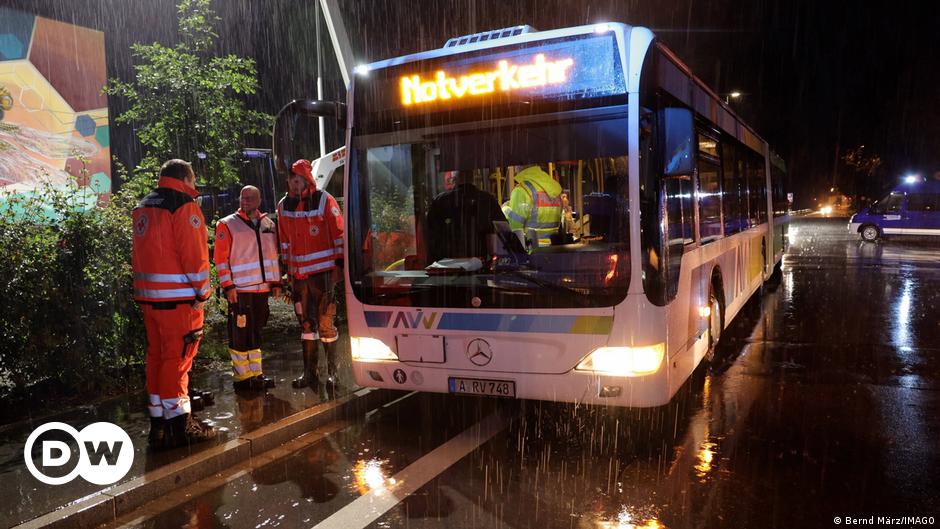cross-posted from: https://lemmy.zip/post/16572873
The southern states of Bavaria and Baden-Württemberg have been inundated, causing dam bursts and prompting dramatic rescues. States of emergency have been declared in several areas with more heavy rain expected.
Archived version: https://archive.ph/bF7J7
Wasn’t I just reading articles about how awful drought was afflicting Germany?
What are the watersheds in the affected area?
Looks like the water that falls in Munich ultimately winds up in the Danube.
The water that falls in Stuttgart ultimately winds up in the Rhine.
kagis
https://www.icpdr.org/tasks-topics/topics/droughts/severe-droughts-danube-river-basin
Severe Droughts in the Danube River Basin
18 August 2022
As the climate crisis worsens, severe droughts devastate European landscapes. According to the data published by the European Drought Observatory, more than 60% of land in the European Union and United Kingdom – an area nearly the same size as India (!) – is now affected by drought conditions. The Danube River Basin and the Danube itself have been affected by serious droughts in the past, e.g., in 2003, 2015, and now again one of the most feared natural phenomenon has gripped much of the Danube River Basin.
https://www.bbc.com/news/world-europe-62519683
Drought hits Germany’s Rhine River: ‘We have 30cm of water left’
12 August 2022
As Europe lives through a long, hot summer, one of the continent’s major rivers is getting drier - posing major problems for the people and businesses that rely on it.
It’s not unusual for water levels to drop here but, Captain Kimpel says, it’s happening more frequently. “We used to have a lot of floods. Now we have a lot of low waters.”
EDIT: That was 2022. What about 2021?
https://en.wikipedia.org/wiki/2021_European_floods
In July 2021, several European countries were affected by severe floods. Some were catastrophic, causing deaths and widespread damage. The floods started in the United Kingdom as flash floods causing some property damage and inconvenience. Later floods affected several river basins across Europe including Austria, Belgium, Croatia, Germany, Italy, Luxembourg, the Netherlands, and Switzerland.[8] At least 243 people died in the floods, including 196 in Germany,[9] 43 in Belgium,[2] two in Romania,[3] one in Italy[4] and one in Austria.[5]
And that was the Rhine.
How about 2023?
High water levels in the Rhine and its tributaries have led to flooding this week in Germany and the Netherlands amid a spell of wet weather.
Rivers have been continuing to surge after several storms hit Germany in quick succession, leaving rainwater building up on already waterlogged landscapes.
I feel like there isn’t a lot of middle room between “too much rain” and “too little rain” here.
Extreme drought makes the issue worse, when the surface is too dry it does not absorb water quickly, meaning you get more runoff. If feels counter intuitive, but it’s true.
You might have noticed this when watering a completely dried out plant. The water stays on the surface of the soil longer.
Not quite correct, if I remember correctly dry soil adsorbs more water and quicker (by default) than waterlogged soil. But when is been dry for a long time a hydrophobic film forms, causing a temporary delay in water adsorption. I think it can impact flash flooding, but it washes off fairly quickly and then adsorption returns to expected.
Yup, we are experiencing more extreme weather situations. Until 2022 it was unusually dry, now 2023 and 2024 had relatively more rain, sometimes in a very short timespan causing flooding.
It’s 2024 right now ;)
Yep, that’s what climate change brings us. Extreme weather fluctuations in a short amount of time. Just like it was predicted.
At least in my area in NRW (west Germany) we’ve had pretty consistent rain over the last couple years. Haven’t seen this much of it in way over a decade. I think the most affected drought regions were in the east though.
First it was dry, then wet :)
I can confirm, it’s really very wet here
Agreed
pärnu kinda.
This is the best summary I could come up with:
Residents in the southern German states of Bavaria and Baden-Württemberg have been urged to exercise extreme caution Saturday as dramatic evacuations take place across the region.
Train service between the Bavarian capital Munich and Bregenz, Austria, as well as Zurich, Switzerland, were canceled Saturday.
In Fischach, west of Munich, emergency services workers had to rescue residents stranded in their homes with helicopters when the local Schmutter River flooded.
Authorities in Diedorf near Augsburg, for instance, told residents that it was no longer enough for them to simply move to the upper floors of their homes, ordering them to leave as floodwaters continued to rise.
Evacuations in the region began Friday evening, with an apartment building in Lindau, Bavaria, emptied as a precautionary measure.
In the Lake Constance district of Baden Württemberg some 1,300 people were also asked to leave their homes due to the risk of flooding.
The original article contains 348 words, the summary contains 142 words. Saved 59%. I’m a bot and I’m open source!
Didn’t they recently also have extreme flooding?with all due respect, but I mean you live right next to the dyke experts, take a fucking hint.
Rivers are different. If you simply box them in with dykes upstream you’ll just have more flooding downstream.
Depends on the river. With those Elbe floods that gave upstream so much trouble once the flood reached the tidal area it either hit a low tide which basically just soaks everything up or a high tide, which still was below spring or storm tide levels.
Generally speaking though and tidal systems aside (which arguably are more coastline than rivers) you should always have regions that you are willing to flood. There’s plenty of places where seasonal flooding was the norm in the past and they’re very valuable biotopes, those should be restored where possible, and even when not flooding a couple of fields and paying out the farmers is rather less of a headache than dealing with uncontrolled flooding. Short video about a flood forest. Bonus: Frozen.
If you mean the Dutch, they also have a lot trouble locally with flooding.
??? We have a costal people, too. This is not a know-how issue.
Yes and no. In the north we simply don’t build stuff where it could get flooded, or accept that it will be flooded. E.g. Hamburg’s Fischmarkt is getting flooded quite regularly (spring/storm tides), no biggie it’s built to handle it just let it happen it’s not like those cobblestones would be priceless artifacts. Meanwhile, in more mountainous regions places started to think “hmm it was silly of our ancestors to build the village up the hill, we should build new stuff down in the valley by the river” because they hadn’t seen a flash flood in a generation.
In short, the issue here is that the people there don’t know how (sorry) water comes from above, below, and the sides. Couldn’t happen up here that’s every other day of the week.
Fixing these kinds of issues are massive undertakings. First you need to check the whole path and start in specific places, because if you start in the wrong place you move the issue to another point where the potential for disaster might be even bigger.
For example, the water level before a dyked area is raised allowing water to pass over a natural barrier and flood an entire valley. Or you move the issue downstream and flood larger areas. When dealing with nature, you are dealing with massive forces.
The Dutch Duke system is a product of hundreds of years of development, and in some cases costly trial and error.







